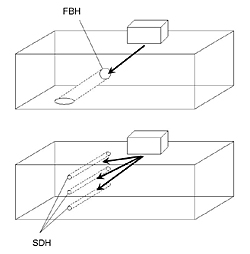SDH and FBH
Side-Drilled Hole and FBH – Flat-Bottomed Hole
SDH – Side-Drilled Hole and FBH – Flat-Bottomed Hole are the two main calibration reflectors which are used in ultrasonic testing. The FBH is drilled into calibration blocks so that the flat end face presents a circular disc perpendicular to the beam (see Figure, top). The FBH is a smooth planar reflector, which gives a signal similar to that of a smooth crack or LOSWF of similar size. The FBH is also the practical implementation of the disc-shaped reflectors used to build up the DGS diagram (see the link on the left).

However, any FBH will only be perpendicular to one beam angle and a different set of FBHs would be needed to calibrate a probe with a different beam angle. A more versatile reflector is the SDH, which is also easier to produce than the FBH. The SDH is drilled parallel to the scanning surface and presents the same reflector to all beam angles. A single calibration block containing SDHs at different depths can therefore be used to generate a DAC (see the link on the left) for any probe. The diameter of a FBH or SDH is often denoted by the Ø symbol.
For more information on SDH and FBH see:
BS EN 583-2:2001 Non-destructive Testing – Ultrasonic examination – Part 2 Sensitivity and range setting
Ultrasonic Flaw Detection for Technicians, J C Drury (can be obtained from BINDT Bookstore at www.bindt.org/shopbindt/books)
What the hec?! articles are not intended to be the definitive account on the topic or acronym in question. Readers’ comments and contributions are welcomed. Email: ndtnews@bindt.org

However, any FBH will only be perpendicular to one beam angle and a different set of FBHs would be needed to calibrate a probe with a different beam angle. A more versatile reflector is the SDH, which is also easier to produce than the FBH. The SDH is drilled parallel to the scanning surface and presents the same reflector to all beam angles. A single calibration block containing SDHs at different depths can therefore be used to generate a DAC (see the link on the left) for any probe. The diameter of a FBH or SDH is often denoted by the Ø symbol.
For more information on SDH and FBH see:
BS EN 583-2:2001 Non-destructive Testing – Ultrasonic examination – Part 2 Sensitivity and range setting
Ultrasonic Flaw Detection for Technicians, J C Drury (can be obtained from BINDT Bookstore at www.bindt.org/shopbindt/books)
What the hec?! articles are not intended to be the definitive account on the topic or acronym in question. Readers’ comments and contributions are welcomed. Email: ndtnews@bindt.org